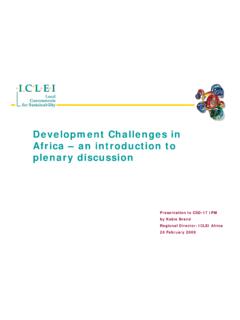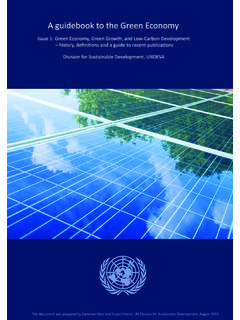Transcription of Sustainable Development Goals FACT SHEET
1 1 Sustainable Development Goals FACT SHEET Goal 1: End poverty in all its forms everywhere Globally, the number of people living in extreme poverty has declined by more than half from billion in 1990. However, 836 million people still live in extreme poverty . About one in five persons in developing regions lives on less than $ per day. Southern Asia and sub-Saharan africa are home to the overwhelming majority of people living in extreme poverty . High poverty rates are often found in small, fragile and conflict-affected countries. One in four children under age five in the world has inadequate height for his or her age. Goal 2: End hunger, achieve food security and improved nutrition and promote Sustainable agriculture Globally, the proportion of undernourished people in the developing regions has fallen by almost half since 1990, from in 1990-1992 to in 2014-2016.
2 However, one in nine people in the world today (795 million) are still undernourished. The vast majority of the world s hungry people live in developing countries, where of the population is undernourished. Asia is the continent with the hungriest people two-thirds of the total. The percentage in southern Asia has fallen in recent years, but in western Asia it has increased slightly. Sub-Saharan africa is the region with the highest prevalence (percentage of population) of hunger. About one person in four there is undernourished. Poor nutrition causes nearly half (45%) of deaths in children under five million children each year. One in four of the world s children suffer stunted growth. In developing countries the proportion rises to one in three. 66 million primary school-age children in developing countries attend classes hungry, with 23 million in africa alone.
3 Agriculture is the single largest employer in the world, providing livelihoods for 40% of today s global population. It is the largest source of income and jobs for poor rural households. 2 500 million small farms worldwide, most still rain fed, provide up to 80% of food consumed in a large part of the developing world. Investing in smallholder farmers is an important way to increase food security and nutrition for the poorest, as well as food production for local and global markets. Goal 3: Ensure healthy lives and promote well-being for all at all ages Child health 17,000 fewer children die each day than in 1990, but more than six million children still die before their fifth birthday each year. Since 2000, measles vaccines have averted nearly million deaths. Despite global progress, an increasing proportion of child deaths are in sub-Saharan africa and Southern Asia.
4 Four out of every five deaths of children under age five occur in these regions. Maternal health Globally, maternal mortality has fallen by almost 50% since 1990. In Eastern Asia, Northern africa and Southern Asia, maternal mortality has declined by around two-thirds. But, the maternal mortality ratio the proportion of mothers that do not survive childbirth compared to those who do in developing regions is still 14 times higher than in the developed regions. Only half of women in developing regions receive the recommended amount of health care. HIV/AIDS By 2014, there were million people accessing antiretroviral therapy, an increase from just 800,000 in 2003. New HIV infections in 2013 were estimated at million, which was 38% lower than in 2001. At the end of 2013, there were an estimated 35 million people living with HIV. At the end of 2013, 240,000 children were newly infected with HIV.
5 3 Goal 4: Ensure inclusive and equitable quality education and promote lifelong learning opportunities for all Enrolment in primary education in developing countries has reached 91%, but 57 million children remain out of school. More than half of children who have not enrolled in school live in sub-Saharan africa . An estimated 50% of out-of-school children of primary school age live in conflict-affected areas. Children in the poorest households are 4 times as likely to be out of school as children in the richest households. The world has achieved equality in primary education between girls and boys, but few countries have achieved that target at all levels of education. Among youth aged 15 to 24, the literacy rate has improved globally from 83 per cent to 91 per cent between 1990 and 2015. Goal 5: Achieve gender equality and empower all women and girls In Southern Asia, only 74 girls were enrolled in primary school for every 100 boys in 1990.
6 By 2012, the enrolment ratios were the same for girls and for boys. In sub-Saharan africa , Oceania and Western Asia, girls still face barriers to entering both primary and secondary school. Women in Northern africa hold less than one in five paid jobs in the non-agricultural sector. In 46 countries, women now hold more than 30% of seats in national parliament in at least one chamber. Goal 6: Ensure availability and Sustainable management of water and sanitation for all In 2015, 91% of the global population is using an improved drinking water source, compared to 76% in 1990. However, billion people lack access to basic sanitation services, such as toilets or latrines. Each day, an average of 5,000 children die due to preventable water and sanitation-related diseases. Hydropower is the most important and widely used renewable source of energy and as of 2011, represented 16% of total electricity production worldwide.
7 4 Approximately 70% of all available water is used for irrigation. Floods account for 15% of all deaths related to natural disasters. Goal 7: Ensure access to affordable, reliable, Sustainable and modern energy for all billion people one in five globally still lack access to modern electricity. 3 billion people rely on wood, coal, charcoal or animal waste for cooking and heating. Energy is the dominant contributor to climate change, accounting for around 60% of total global greenhouse gas emissions. Energy from renewable resources wind, water, solar, biomass and geothermal energy is inexhaustible and clean. Renewable energy currently constitutes 15% of the global energy mix. Goal 8: Promote sustained, inclusive and Sustainable economic growth, full and productive employment and decent work for all Global unemployment increased from 170 million in 2007 to nearly 202 million in 2012, of which about 75 million are young women and men.
8 Nearly billion people live below the US$2 poverty line and poverty eradication is only possible through stable and well-paid jobs. 470 million jobs are needed globally for new entrants to the labour market between 2016 and 2030. Small and medium-sized enterprises that engage in industrial processing and manufacturing are the most critical for the early stages of industrialization and are typically the largest job creators. They make up over 90% of business worldwide and account for between 50-60% of employment. 5 Goal 9: Build resilient infrastructure, promote inclusive and Sustainable industrialization and foster innovation About billion people in the developing world are facing difficulties in accessing electricity full time. billion people worldwide lack access to basic sanitation and almost 800 million people lack access to water, many hundreds of millions of them in sub-Saharan africa and South Asia.
9 1 to million people do not have access to reliable phone service. For many African countries, particularly the lower-income countries, infrastructure constraints affect company productivity by around 40%. Manufacturing is an important employer, accounting for around 470 million jobs worldwide in 2009 or around 16% of the world s workforce of billion. It is estimated that there were more than half a billion jobs in manufacturing in 2013. Industrialization s job multiplication effect has a positive impact on society. Every one job in manufacturing creates jobs in other sectors. In developing countries, barely 30% of agricultural production undergoes industrial processing. In high-income countries, 98% is processed. This suggests that there are great opportunities for developing countries in agribusiness. Goal 10: Reduce inequality within and among countries On average and taking into account population size income inequality increased by 11% in developing countries between 1990 and 2010.
10 A significant majority of households in developing countries more than 75% are living today in societies where income is more unequally distributed than it was in the 1990s. Children in the poorest 20% of the population are still up to three times more likely to die before their fifth birthday than children in the richest quintiles. Social protection has been significantly extended globally, yet persons with disabilities are up to five times more likely than average to incur catastrophic health expenditures. Despite overall declines in maternal mortality in the majority of developing countries, women in rural areas are still up to three times more likely to die while giving birth than women living in urban centres. 6 Goal 11: Make cities and human settlements inclusive, safe, resilient and Sustainable Half of humanity billion people lives in cities today.












